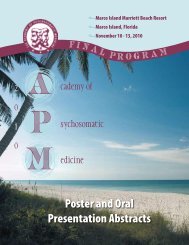Table of Contents - Academy of Psychosomatic Medicine
Table of Contents - Academy of Psychosomatic Medicine
Table of Contents - Academy of Psychosomatic Medicine
Create successful ePaper yourself
Turn your PDF publications into a flip-book with our unique Google optimized e-Paper software.
consciousness and mild disorientation. Despite her altered<br />
mental status, we were able to obtain a history concerning<br />
for antifreeze ingestion. The renal biopsy confirmed the diagnosis<br />
and the patient later admitted to the ingestion.<br />
Conclusions: This case is important because it is the first<br />
reported case <strong>of</strong> chronic ethylene glycol poisoning as a<br />
method <strong>of</strong> self-harm and it underscores the importance <strong>of</strong> a<br />
detailed review <strong>of</strong> the history in the evaluation <strong>of</strong> delirium.<br />
Early recognition <strong>of</strong> ethylene glycol poisoning is essential for<br />
proper care including prompt treatment with fomepizole.<br />
30. A Case <strong>of</strong> Cerebellar Cognitive Affective<br />
Syndrome Treated with Olanzapine<br />
Presenting Author: Jason Caplan, MD<br />
Co-Author: Gunjan Parikh, MD<br />
Introduction: Recent investigations have revealed that the<br />
cerebellum is involved in more than its previously postulated<br />
function <strong>of</strong> the coordination <strong>of</strong> movement. It has been suggested<br />
that the cerebellum has an integral role in the regulation<br />
<strong>of</strong> cognitive and emotional processing, with cerebellar lesions<br />
resulting in a constellation <strong>of</strong> symptoms that has been<br />
termed the cerebellar cognitive affective syndrome (CCAS).<br />
Despite this evolving contemporary body <strong>of</strong> evidence, no<br />
clear pharmacological strategies have been developed for<br />
the management <strong>of</strong> CCAS.<br />
Case Report: A 64 year-old man with no prior psychiatric<br />
history was admitted with ataxia, diplopia, weight loss,<br />
and poor self-care worsening over the preceding several<br />
months. He was found to have a left upper lobe lung mass<br />
diagnosed as adenocarcinoma with another mass centered<br />
in the cerebellar vermis and extending into the cerebellar<br />
hemispheres. After craniotomy and resection (confirming<br />
metastatic disease), psychiatric consultation was requested<br />
for persistently bizarre behavior. On exam, he was found<br />
to have intact cognition, an expansive affect and prominent<br />
paranoid and grandiose beliefs - accusing the nursing staff<br />
<strong>of</strong> poisoning and physically assaulting him, and calling an attorney<br />
from the bedside. His odd behavior included the collecting<br />
and careful arrangement <strong>of</strong> urinals on the floor <strong>of</strong> his<br />
room. He had not been treated with steroids and there was<br />
no evidence <strong>of</strong> delirium on exam. On evaluation, the onset<br />
<strong>of</strong> psychotic behavior and expansive mood immediately after<br />
the resection <strong>of</strong> a large cerebellar lesion were thought to be<br />
most consistent with cerebellar cognitive affective syndrome<br />
(CCAS). Olanzapine 5mg twice daily was started, which the<br />
patient tolerated well. At one month follow-up, his paranoia<br />
had resolved and his executive functioning, reasoning, and<br />
mood had dramatically improved.<br />
Discussion: The abnormal behaviors seen with CCAS are<br />
marked by inappropriate (either excessive or diminished) responses<br />
to the environment analogous to the over- and undershoot<br />
<strong>of</strong> movement resulting from cerebellar lesions. The<br />
cerebellum is an important way station in the complex neural<br />
circuitry subserving cognition and emotion. It is important in<br />
patients with cerebellar dysfunction to carefully assess for<br />
cognitive and affective disturbance to allow for timely diagnosis<br />
and treatment <strong>of</strong> this syndrome. Further investigation<br />
is warranted to establish the benefit <strong>of</strong> olanzapine and other<br />
13<br />
psychotropic medications in the treatment <strong>of</strong> psychiatric disturbances<br />
associated with CCAS.<br />
31. Posterior Reversible Encephalopathy<br />
Syndrome: Delirium with Unique<br />
Neuroradiologic Features<br />
Presenting Author: Jason Caplan, MD<br />
Co-Author: Gunjan Parikh, MD<br />
Introduction: Posterior reversible encephalopathy syndrome<br />
(PRES) is a state <strong>of</strong> neurotoxicity with a characteristic<br />
watershed imaging pattern <strong>of</strong> cerebral edema that is common<br />
to a number <strong>of</strong> complex acute systemic conditions. Delirium<br />
is a presenting symptom in nearly all cases <strong>of</strong> PRES.<br />
Little mention has been made in the psychiatric literature <strong>of</strong><br />
this increasingly recognized syndrome. This poster will describe<br />
the clinical presentation and exhibit the neuroradiologic<br />
features associated with PRES.<br />
Discussion: PRES has been most commonly described in<br />
association with severe hypertension, toxemia <strong>of</strong> pregnancy,<br />
and with cyclosporine immunosuppression after organ transplantation,<br />
however, the syndrome has been increasingly<br />
reported in other conditions, including sepsis, autoimmune<br />
diseases, and in the context <strong>of</strong> cancer therapy. Patients typically<br />
present with encephalopathy, seizures, a spectrum <strong>of</strong><br />
visual deficits (including cortical blindness), and headache.<br />
Given that the clinical presentation is <strong>of</strong>ten non-specific,<br />
PRES has become synonymous with a unique neuroimaging<br />
pattern on magnetic resonance imaging. The basic<br />
PRES pattern resembles symmetric hemispheric edema in<br />
brain watershed zones with the parietal and occipital lobes<br />
most commonly affected. The mechanism <strong>of</strong> PRES remains<br />
unknown. The current favored theory based on animal studies<br />
suggests that severe hypertension exceeds the limits <strong>of</strong><br />
cerebral autoregulation resulting in injury to the capillary bed<br />
and hyperperfusion which manifests as vasogenic edema<br />
on neuroimaging. Since PRES has now been reported in the<br />
absence <strong>of</strong> hypertension, an alternative theory (involving inflammatory<br />
cytokine response associated with vasoconstriction<br />
and hypoperfusion) is gaining traction.<br />
Conclusion: The encephalopathy <strong>of</strong> PRES represents a<br />
subtype <strong>of</strong> delirium with unique neuroradiological features. It<br />
is important that consultation psychiatrists are aware <strong>of</strong> this<br />
phenomenon to aid in its timely diagnosis and treatment.<br />
32. Paraneoplastic Encephalitis in a Patient<br />
with Mature Ovarian Teratoma and NMDA<br />
Receptor Antibodies<br />
Presenting Author: Diana Domnitei, MD<br />
Co-Author: Junji Takeshita, MD<br />
Purpose: We describe a 20-year-old patient with paraneoplastic<br />
encephalitis, N-Methyl-D-aspartate (NMDA) receptor<br />
antibodies and mature ovarian teratoma (OT).<br />
Methods: Diagnosis, management, including psychiatric<br />
management, hospital course, and current literature is<br />
described.



